|
 |
The Memotech MTX Series |
 |
Memotech MTX Hardware Options
A larger selection of more detailed photos is available on
the
Photos page.
I have tried to include as many of the different
Memotech options that I have come across but I will not have
covered every possible configuration, either on this page, or
the Photos page. As I have been
researching Memotech's products, it has become obvious that
there was a lot of "custom" configurations shipped. I suspect
that this may have been almost a "make do and mend"
approach by Memotech, that probably became necessary as the
business started to fail and cost cutting was a major focus of
the company.
|
Original Memotech Hardware &
Options |
| MTX500 32kB RAM (other specs
here) |
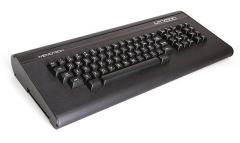 |
| MTX512 64kB RAM (other specs
here) |
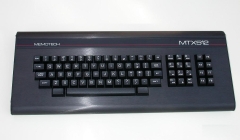 |
| RS128 128kB RAM (other specs
here) I have not been
able to find a good photo of the RS128, the best I have
found is the one, cropped from
an article on
Bilgisayar Müzesi's blog. (I think that the site is
in Turkish.) |
 |
| RS128 - This one was advertised on ebay UK in
2013 (from Finland) Photo courtesy of Aki Sivula There are some additional pictures on the
Photos page. |
 |
| MTX512S2 256kB RAM, although 256k was
installed, due to the way the machine was configured,
something less than that
was useable (other
specs here) There
were additional options for the Series 2 which included
a version of the 80 column board which fitted inside the
MTX case, a 3.5" disc drive add-on similar to the SDX
version. |

 |
| MTX512 Undeveloped Prototype This is an
extended length MTX, some 3 1/2" longer than the
standard MTX. Geoff Boyd commented "I believe this was a
(very) limited run of MTX 512s with single drive Floppy
disk Controller card and 80 Column card in the extended
enclosure." Other than the standard MTX computer
board, the machine shown has no additional internals
fitted and the rear panel identification labels are
missing.
I don't think that the prototype ever made it into
production.
There are some additional pictures on the
Photos page.
Information & photos from
Binary Dinosaurs / Geoff Boyd. |
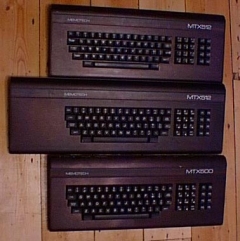 |
| MTX2000 There are a few references on the
internet to Memotech MTX2000 systems, but these were not
a product marketed in the UK. The 3.5in disk CP/M
MTX2000 series were originally made in small quantities
at the behest of the Italian distributor who invested in
Memotech Computers Ltd and then later used as
computer for the Videowall control systems.
Many of these systems had silicon disk/ram disk + ROM
CP/M systems. There was never an attempt by Memotech
Computers Ltd to sell these as computer systems.
(Information comes courtesy of Geoff
Boyd, 09/11/2012, from his recollection of the Videowall
business) |
Photo coming soon |
| Business/2 Marco Virginio in Italy has
Memotech Business/2 system. Perhaps this is another
model manufactured for the Italian market? Marco's
system has very similar hardware to the MTX2000
described above, but the MTX logo on the keyboard has
been replaced by the "Business/2" logo.
I have been unable to contact Marco, so this photo is
the one from Andy's site. |
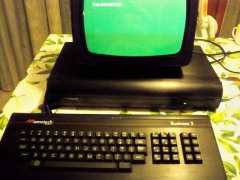 |
Another Business/2 ?
In December 2012,
Peter Kretzschmar)
picked up this interesting item, although the keyboard
has an "MTX512" label fitted, the case for the main unit
looks identical to Marco's "Business/2". |
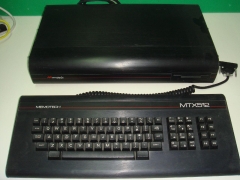 |
| MTX512 in red -
the Holy Grail of Memotechs? When Memotech were
bidding for the Russian contract, a couple of
demonstration machines were produced in red cases. I think there may
only have been two of these demo models in existence, although
there are a couple more standard MTXs which have had red
covers fitted using extras from the demo run (like this
one), I know where one
such machine is. The
chances of finding a genuine red demo MTX is probably
somewhat less than winning the lottery! |

 |
| MTX512 in red -
the show model may have actually looked
like this Geoff Boyd has
advised me that the prototypes produced for the Russian
contract negotiations were slightly cut-down versions of
the MTX512, the numeric keypad was removed to reduce
cost. Most of the prototypes were the standard black
colour and only a couple of red ones were produced for
"show". |
 |
MTX512
in red - the only other example that I know of.
This one owned by Noel Long, like Jim's, this is a
standard MTX with a red keyboard cover fitted, rather
than one of the actual demo models.
Photo courtesy of
Noel Long |
 |
| ROMPAK Cartridge
The edge connector at the left hand side of the MTX,
normally hidden under a plastic cover, was a
ROM
cartridge port. A limited number of games were
available on cartridge, as well as the Node
ROM for the Memotech
Token
Ring Network called the Oxford Ring. |
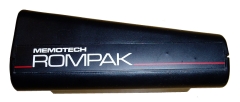 |
| Only requiring a subset of the expansion bus
signals, the ROMPAK had a half-length, 30-way, edge
connector. |
 |
| The ROMPAK is a very simple device, consisting of an
EPROM, a 47 nF decoupling capacitor and the half length
edge connector.
GROM
from the bus is connected to
CE and
OE of the
EPROM, with A0-A12 and D0-D7 connected as one would
expect.
The EPROM in the ROMPAK shown contains the Node Ring
software, which [Tony] spent a lot of time on at Witney. |
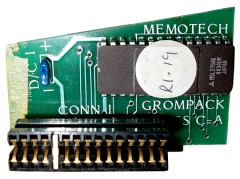 |
| The masking tape is not for insulation, but to wedge
the PCB in one slot inside the plastic case as it is too
short to reach the other slot. [Tony's] Speculator
fitted inside the same ROMPAK case - just!
ROMPAK photos and technical details courtesy of Tony
Brewer |
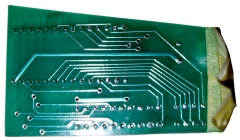 |
| Memotech Speculator Created by Tony Brewer,
the Speculator was built into a ROM cartridge case that
plugged into the MTX edge connector. Used in conjunction
with a supporting tape, it allowed the MTX to run a
number of ZX Spectrum games. Technical details of the
Speculator design can be found on
this page.
There are a couple of reviews of the Speculator on
the Articles
page.
Photo courtesy of Tony Brewer himself! |
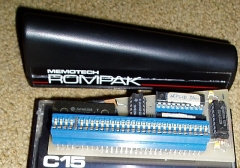 |
| Thanks to Martin Allcorn, I now have my own Memotech
Speculator - complete with "production" version of the
Speculator case |
 |
| Reverse side of the Speculator ROMPAK |
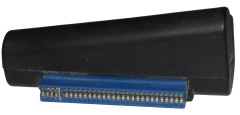 |
Another, slightly different
version of the Games ROM board
Although still
labeled as a "GROMPAC", the connector on this board is
mounted the other way up from the ROMPACK board above
and this board must be connected to the internal
expansion connector.
In that configuration, the
PCB would be upside down, with the components on the
bottom. That probably explains why the PCB sits at an
angle of about 45° to the connector so that the EPROM
would be clear of the bottom of the case. |
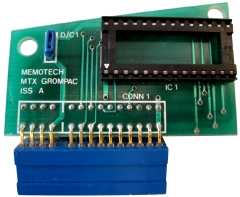 |
Another, slightly different version of the Games ROM
board - solder side
Internal mounting would
preclude the use of the Node ROM (as an RS232 board is
required which must be attached to the internal
connector). Attaching a single game ROM to the internal
connector makes little sense.
Therefore, it is
pretty certain that this design of ROM board was
developed to allow the system to be run with a copy of
the Demo ROM mounted internally, likely used for in shop
demonstration purposes. |
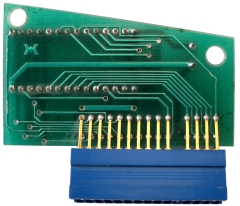 |
| Option ROM Board
- this is my ROM board with
Pascal ROMs fitted |
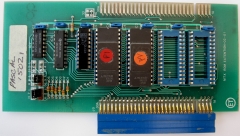 |
| Option ROM Board - this one has NewWord and
Pascal ROMs fitted |
 |
|
Option ROM Board
- this is an unusual example, it is mounted in an SDX
disk controller type enclosure, allowing the ROM board
to be plugged in externally.
All of the
other ROM card examples that I have seen have an edge
connector plug on the left hand side and a bare board
edge connector on the right, allowing other expansion
cards to be installed internally alongside the ROM
board.
Photo courtesy of Adrian
Graham of
binary dinosaurs |
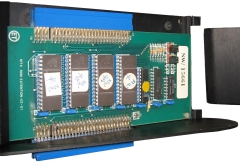 |
RAM
Expansion board
The most common expansion
board seen in MTX computers, many "MTX512"s were made up
of a 32k (MTX500) system board with an expansion memory
board populated with the additional 32k.
The
board could hold 16 RAM chips, this one (courtesy of
Manfred Flume) has two additional banks of 64k RAM
fitted with a custom PAL created by Manfred. |
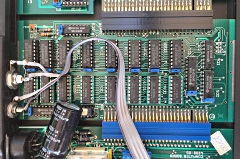 |
RAM Expansion Board - soldered
The edge connectors used by Memotech were a frequent
cause of problems, to such an extent, the many of the
factory fitted RAM expansion boards were soldered to the
main PCB. This makes further expansion of the computer
somewhat difficult.
(Photo courtesy of Jason
Kelly) |
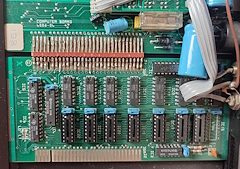 |
| RS232 Communications and FDX System Interface Card
The header plug to the left of the
DART is
the connector for the 2x25 way "D" type sockets on the
rear of the case - RS232-0 and RS232-1
The header plug at the top of the board is the
connector for the FDX disk system.
I know of a limited number of boards that did not
have the DART or other RS232 chips fitted and only
supported the FDX interface. |
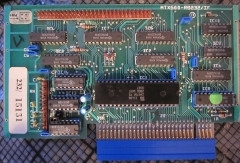 |
FDX
System Interface Card
An example of
the FDX Interface board without the RS232 components
fitted.
Courtesy of Manfred Flume
|
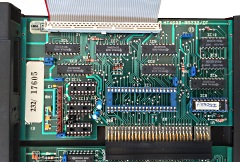 |
| This is the combined 80
Column and RS232 card designed to mount inside the MTX
and allow SDX disk systems to run CP/M. The 80 column
functionality is the same as the FDX board and it has
the same RGB and composite outputs. This one is fully
populated, but some boards only had the 80 Column
functionality and were missing the Z80 DART and support
chips.
This example is soldered to the MTX internal edge
connector, making its removal somewhat problematic! |
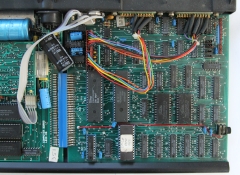 |
| FDX Disc System
( when is a disk not a disk?
) This was the first and
largest add-on for the MTX, it was large black expansion
unit which attached to the MTX through a short length of
ribbon cable connected between the bottom of the FDX
case and the interface connector on the RS232 board
inside the MTX. My FDX was fitted with 2 x 5.25" floppy
disks and was priced at £870 when I bought it.
A version fitted with 1 x 5.25" floppy disk and a
256K
Silicon Disk was also available at £995. Additional
256K Silicon Disks could also be added at £385 each.
The FDX unit contained a 6" card frame which held
the floppy disk interface card, an 80 column video card
(outputting RGB and composite video) as well as space
for a number of the Silicon Disc cards (an option an
£385 each). The FDX also provided power to the MTX, the
original PSU was not needed, and also had cut-outs for expansion
connectors for additional 5.25" and 8" floppy disk
drives. The FDX was based on the design of the
SM1 computer which was used for software
development before the MTX was available. This can be
seen from the FDX system schematics on the
manuals page. |

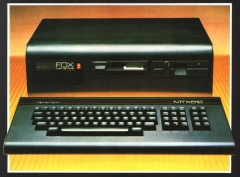 |
| FDX Single Disc System Memotech also
released a budget (£399) single disk drive, non-CP/M FDX
built in the same case as the twin-drive FDX. The single
drive version connected to the MTX in the same way as
the twin disk version, i.e., using a ribbon cable on the
base of the FDX which connected to the combined
RS232/Bus Interface card in the MTX. However, the single
drive version did not have the 80 column video card and
used the video output from the MTX VDP.
Unlike the dual drive version, this FDX did not
supply power to the MTX, the stand-alone MTX PSU was
still required. This FDX does not have a case fan.
The system was supplied with a 40 column version of
NewWord and seven other games and utility programs. You
can read a review on the single drive FDX on the
Articles page.
The system could be upgraded with the 80 column card,
silicon disks, CP/M and an additional floppy or hard
disk. |
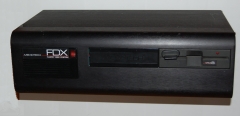
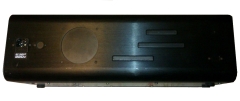 |
| HDX Disc System There was also a hard disk
version of the FDX available which could accommodate a
small (10, 20 or 32 MB) hard disk installed in an FDX
case alongside a single 1MB floppy disk. According to the
Phoenix Operator's
Manual, the HDX used an 8MHz Z80H processor. I have never seen
one of these, and given the expected price (unknown), I
would guess that very few were sold. It might even
have looked like this! |
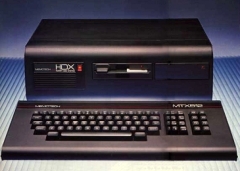 |
| SDX Disc System - Older Version
The SDX was available in a number of versions, the first version consisted of an SDX
controller unit which attached to the edge connector on
the left hand side of the MTX case and had an IDC
connector at the rear to connect to the floppy disk
drive(s).
This controller supported up to two disk drives, a
5.25" drive is shown, but it was also possible to
connect 3.5" drives to the same controller. The mains
powered floppy drive also supplied 5VDC to the SDX
controller via a 3.5mm jack output. |
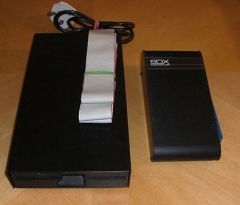 |
| SDX Disc System - Newer Version
An updated version had a 3.5" floppy disk drive built
into the SDX controller case which again attached to the MTX edge connector. This was the option available by
the time that the MTX512S2 was released. The combined
disk controller / floppy disk unit required an
additional MTX power supply to provide power.
The MTX2000 and Business/2 systems in their slimmed
down FDX-like also had an internal disk controller and
3.5" floppy disk drive. |
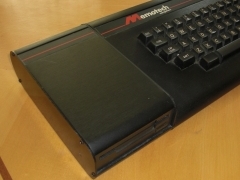 |
| 100K / 250K Disk Drives
Memotech also released a "low cost" disk drive,
available with 100K (£199) and 250K (£249) (unformatted)
capacities. From its description, it seems that this
drive used the RS232/FDX Bus Interface card (£35, without
RS232) and a ROM based version of BASIC. I have seen
references to these drives in the various user group magazines but have never
seen either the drive or controller card.
Memotech Product Announcement courtesy of
Jim Wills |
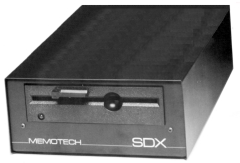 |
100K / 250K Disk Drives
The
description in the product announcement referenced above
is not accurate, having the disk drive connected to the
RS232 board makes no sense. One of these 250k disk
drives was advertised on eBay UK in 2024 along with the
older type SDX controller that was shipped with it. This
is almost certain to have been the setup for all of
these 100K/250K drives.
Photo courtesy of Paul
Sampson (eBay seller) |
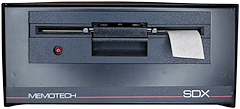 |
| DMX80 Printer
Memotech DMX80 printer - a colour
coordinated, 9-pin, dot matrix printer, manufactured by Panasonic
based on the Panasonic KX-P1090. Software compatible
with an Epson MX80. There are various references to a
DMX100, a 100 cps version, but I think that this was
"vapour-ware" and don't think any were actually shipped. Scanned in 2 pages,
1 printer photograph,
2 technical details |
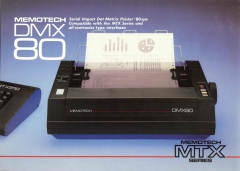 |
| Cassette Tape Recorder I was unaware
that
Memotech had released a branded cassette tape recorder
until one was included with a pair of MTX500s advertised
on ebay.uk in 2013, I would guess that very few of these
were sold. This poor quality photo was captured from
the ebay advert - but the seller, Dave Hickman has
kindly sent me better quality photos that you can see on
the Photos page. I
found a review of a non-Memotech branded Morwood "Datacorder" at
www.freetimeweb.nl, from a review in ZX-computing
from Aug-Sep 1984. |
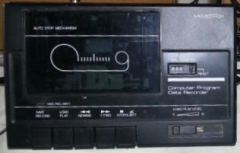 |
| The MTX Computer brochure, scanned in 4 pages :-
1 keyboard close-up,
2 description,
3 expansion options,
4 technical details |
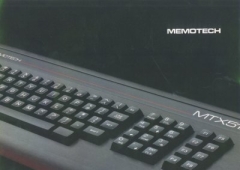 |
|
Internationalisation |
| International character sets and appropriate
keyboard layouts were available for UK, US, Finland,
France, Germany, Spain, Denmark and Sweden. This appears
to have utilised an additional ROM piggy backed onto the
OS ROM and some custom wiring on the motherboard like
this Danish example. Higher resolution photos are
available on the Photos
page
Photo courtesy of
Claus Beakkel |
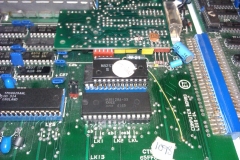 |
|
The Memotech HRX
Multimedia PC (Open the
dedicated HRX page for more
details) |
| Memotech developed a high
resolution graphics package based on the MTX and FDX, called the
HRX which was developed for picture and image
processing.
The features of HRX are described in the
MTX Series
Technical Specification . . . .
"The basic monochrome system uses a single
"colour" plane and gives 4 pages of 256x256x8 bit
storage giving 256 levels of grey per pixel. The
colour system used three colour planes (R, G and
B) giving 224 or 16 million colours
per pixel. This is more than that required for
colour TV (250,000 colour shades) and the extra
storage capacity can be used for picture
processing."
These specifications are likely
pre-production, the hardware schematics show
that the analogue to digital convertors had 6,
rather than 8, bit resolution, giving 218
or 256 thousand colours per pixel. This was
likely done to reduce the cost of the A/D
convertors and associated RAM costs.
The system was designed to allow direct TV or
video camera input into its frame store, the HRX
had a set of analogue to digital converters
which worked at video speed and fast interleaved
DMA storage which allowed data to be written to
the system at video frame rate (88M bit/s). This
allowed the system to grab video frames in real
time and perform real time image enhancement and
processing.
In addition to the real time processing
capability, a software package running on an MTX
computer could perform fast, off-line processing
of pictures stored in the HRX frame memory,
including, in addition to basic dot and vector
line drawing capabilities, such functions as
zoom, shrink, rotate, etc.
Memotech envisaged that applications for the
HRX included graphics design, image enhancement,
animation etc. However, whilst the system was
certainly technically advanced for its time, it
is unlikely that it was commercially successful.
The HRX system gets a brief mention in the The
Home Computer Advanced Course
article on the
Memotech company :-
"Starting with an unexpanded MTX500, the user can add
disk drives and the three graphics controller boards: a
96-bit processor main controller board, a 'Frame
Grabber' and a three channel A/D converter. The
resulting system is able to produce animations, picture
composition and graphic design up to a full typesetting
capacity. The system costs around £4,500."
|
| The HRX was also reviewed by
John J. Anderson, the writer for Creative Computing,
who reviewed the MTX in the June 1984 issue of
the magazine, complete with an HRX image capture
of himself! Despite not being able to locate this article
for a long time, I have just managed to find a copy at
archive.org and
posted it on the
Articles page. |
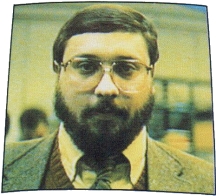 |
Sandwiched between the pages of the MTX512 review, is
a half page devoted to the HRX. Anderson says "There in
front of me was the most incredible video frame grabber
I had ever seen."......"There have been hi-res frame
grabbers before, and there will be more in the future.
But the Memotech hi-res image processor represents a
breakthrough in performance for the price. Sure, it's
pricey - about $14,000 at the current rate of exchange
for the pound sterling. But capability of this quality
cost three times as much before Memotech came on the
scene."
Andy Key recalls that the HRX contained a high
resolution graphics card (at 256x256x18bpp) and had
basic image processing, such as sharpen, blur, scale,
rotate, etc. and was shown at trade shows, but he is not
sure any were ever sold.
Andy also has some copies of screen captures showing
the three
famous actresses (no Kelly though!) below, these
captures were used during system demonstrations and
showed off the impressive (for the time)
capabilities of the HRX at 256x256 pixels.
(These images were originally TIF images, converted to JPG for this web page).
Technical Details
Almost all of the technical details of the HRX have
been lost and I believed that it was highly unlikely
that any detailed technical data would ever be found.
However, Tony Brewer has found some design drawings
amongst the paperwork that he retained from his days at
Memotech and has kindly made them available. I have
created a new page for the HRX
which will eventually host all of this interesting data. |
|
Memotech
Multi-Effect Video Wall |
|
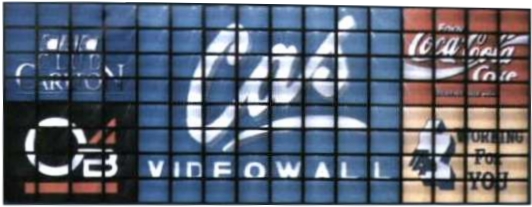 |
|
When the original Memotech company folded, Geoff Boyd
continued marketing and supporting the MTX computer for a while, but
ultimately, repositioned the business to market the
Video
Wall system.
The Video Wall system was a development of the
Memotech HRX, a high resolution digital video frame grabber
(described above). |
|
Memotech Video Wall systems were initially made up of a
Memotech computer (RS128 or
MTX512S2) with a minimum of
128K RAM, attached through the printer port to a black
box (what else?) packed with electronics to drive a wall
of video monitors. Some later
systems were equipped with the MTX 2000 computer, before
the company moved onto the industry standard PC
platform.
A number of advanced Video Wall options such as time
code synchronisation, mouse control, operation of the
"Reflex Touch Controller" etc, required the presence of
an RS232 board in the MTX. The "Reflex" controller used
the RS232 interface to allow the operator to quickly
select any of the available pre-programmed video wall
control sequences using external devices such as an
attached mini-keyboard or commercial lighting systems
controllers, etc. |
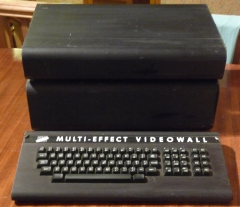 |
|
Cameron Video Systems (CVS) (now called
Cameron
Communications) were Memotech's exclusive
distributors for the Video Wall system, initially in the
UK and Europe, and later worldwide. The User Manual for
the Cameron Video Wall can be found on the
Manuals page.
Latterly, Memotech decided to market the Video Walls
themselves, rather than through their
distributors, Cameron Video Systems.
|
 |
|
The Memotech Video Wall was very successful and was
installed in many high profile venues, including the
Hammersmith Palais in 1987, with an upgrade in 1990. At that time, this was
the biggest club Video Wall in the UK, consisting of 2, 5x5 matrix displays. You can read about it in
Issue 52 of Lighting and Sound International in the
Library pages.
There is a small "Memotech History of Multimedia"
presentation by Geoff Boyd, available
on his web pages
here.
The presentation shows the
Video Wall at the Natural History Museum which used
Memotech technology, at least when it was installed.
(See Slide 7). The photo in the
presentation is of Nick Moore's "Kaleidosphere". There is a small selection of Memotech Video Wall hardware
pictures on the Photos
page and an extensive set of photos of my Video Wall
equipment on the the dedicated
Video Wall Photos page.
Further technical details of Video Wall hardware can
be found in the
Video Wall section of the website.
(Some of the Video wall information comes courtesy
of Geoff Boyd, 09/11/2012, from his recollection of the
Memotech Video wall business)
(Other contributions from Alan
Wilkinson,10/01/2013 and Brian Pipe 03/02/2013) |
|
|
|
Third Party Add-ons from the 1980s |
| |
|
| Jaro Speed Splitter - Split speed RS-232 for
Viewdata
services like
Prestel
etc. I bought one of these which I used with my FDX
and a Pace Linnet V21/V23 modem for accessing Prestel.
It's still in the loft somewhere, I'll post a photo when
I find it! |
|
| SpeakEasy - Genpat Speech Synthesiser (User group
add-on hardware) I've seen this advertised in Memopad,
the user group Magazine, but have not come across the
hardware. It plugged into the edge connector and given
the name, was probably similar to the Spectrum product
of the same name which had a built in speaker. Genpat
price £29.95. Advert from Sinclair Programs,
March 1984, from
World of
Spectrum Archive |
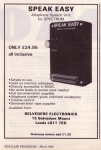 |
Memotalk - Another Speech Synthesizer, this one was
from Denmark. It was designed and built by
Lars Jĝrgensen and distributed by Tevec-Data.
Again, it plugged into the edge connector but did
not have a built in speaker, it required an external
amplifier or Hi-Fi. Genpat price £33.95
Photo taken at
Memofest 2013,
hosted by
Jim Wills, photo by
Andy Key |
 |
Norbit Elektronikk
"ToolBox '84" hobbyist electronics hardware
interface
In early 2021, Jonas O'Brien from
Norway kindly sent me a Toolbox '85 along with an almost
identical box with no branding on it, other than the
port names. I found that there are no
electronics inside - the 9 inputs are just wired
directly to the joystick connector pins. The "POT"
connectors were likely only of use with computers such
as the
Commodore 64 which had analogue input channels
connected via
Atari 2600 compatable joystick ports. |
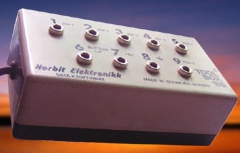 |
|
Enhancements from the present day |
|
Andy Key
|
| In the 1980s,
Andy Key worked for Memotech writing software,
including many of the best games, for the Memotech MTX
range. His in depth knowledge of the Memotech software
is complimented by a great understanding of the
hardware.
Andy has put this knowledge to good use to produce a
range of enhancements for the MTX range, including a
fantastic software emulation (MEMU)
and a number of hardware designs, including :-
|
 |
|
REMEMOTECH
To quote from Andy's site, "REMEMOTECH is a modern-day
re-implementation of a Memotech MTX/FDX/SDX compatible computer.
It implements enough hardware to allow it to run MTX BASIC,
various MTX games and CP/M".
I've "built" one of these and it is
great! - You can see the details of mine
here. |
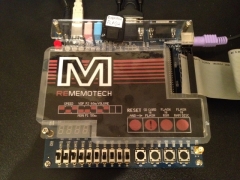 |
| RAM Board |
|
RAM
Expansion / Replacement Board
A RAM expansion card, which can be used in various
configurations to supply RAM to an MTX computer,
including recovering from attempting a
failed RAM
upgrade.
Andy has built a RAM board for me that I hope to use
to recover my
failed MTX500......
The news is that it works great! I
now have a fully working MTX with 0kB on the system board and a 512kB
RAM card installed inside the case. |
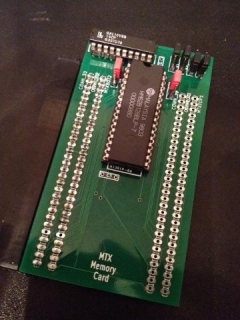 |
| REMEMOrizer |
|
REMEMOrizer
The ultimate add on for 2012 though, is
REMEMOrizer !
Again, in Andy's words, "REMEMOrizer is an add-on for
a real Memotech MTX500, MTX512 or MTX512 S2 computer,
built using hardware and software developed for
REMEMOTECH. It provides" [an 80 column card output to
VGA, an SD card as an alternative to floppy disc,
additional RAM and replacement, improved ROMs].
Andy perfected the REMEMOrizer design in October 2012
and my order went in on the same day - see more details on
my
REMEMOrizer. |
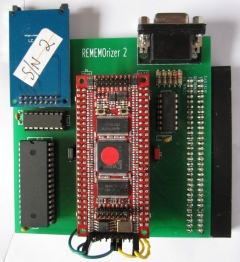 |
|
As of March 2017, REMEMOrizer sales are now up to over
50!
At this rate, Andy will soon need to move into new
premises, here's a sneak preview of the "new"
factory :-) |
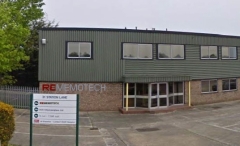 |
|
ROM Board |
ROM
Card
Released at
Memofest 2019,
the ROM card plugs into the cartridge port and has the
flexibility to provide many functions, including games
ROMs, a read-only CP/M system, a Video Wall controller,
etc. etc.
Use Andy's companion
COMtoROM program to convert CP/M .COM files into ROM
images for loading into the ROM |
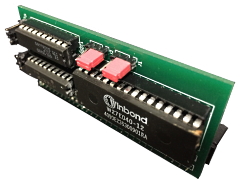 |
|
Martin Allcorn &
Dave Stevenson |
|
|
|
MAGROM |
|
Adding to the modern day enhancements
for the MTX, Martin Allcorn has developed
MAGROM. This is a small board that plugs into
the MTX cartridge port and provides a suite of games
that can be loaded from the ROM.
This is a photo of one of the early
development boards - see here for full details of
MAGROM |
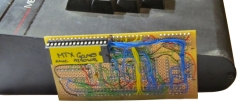 |
Version 1.1 of the production version of MAGROM
I
took Martin's MAGROM design and "productised" it. |
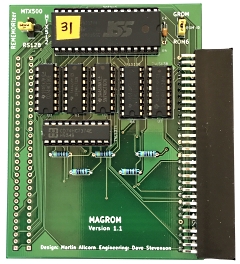 |
|
CFX |
CFX is a spin off of the Compact
Flash storage system developed for
MTXPlus+, our modern day,
fully compatible, MTX "super computer".
It uses a
modified Memotech SDX ROM to give an MTX computer the ability to
load and save data from a CF card using MTX BASIC "USER"
extensions.
Both CFX and MTXPlus+ make extensive use of the code
developed by Andy Key for
his MEMU,
REMEMOrizer and
REMEMOTECH projects described on the
Memotech
pages on his website. |
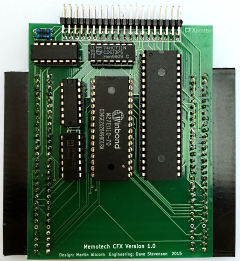 |
|
MTX PC Keyboard Interface |
MTX PC
Keyboard Interface
A small PCB that fits inside an
MTX computer to allow a PC (PS/2 or USB) keyboard to be used
with an MTX. Can either work in parallel with, or instead of,
the existing matrix keyboard.
Designed by Martin Allcorn,
Bill Brendling and myself. |
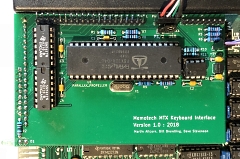 |
|
MTX Multi-Function eXpansion Interface |
The ultimate MTX expansion?
The
Multi-Function eXpansion
board, an internal expansion board that provides up to
512k of RAM, SD card interface and network interface
modules, a full emulation of Memotech CP/M with VGA
output for both the normal MTX video output and the
emulated 80 column board. |
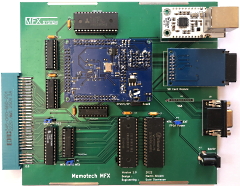 |
|